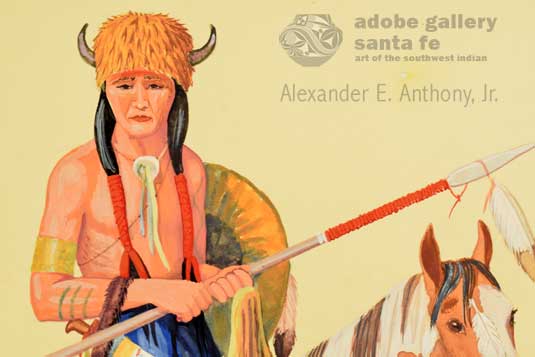Untitled Painting of a Man on Horseback [SOLD]
+ Add to my watchlist Forward to Friend
- Category: Paintings
- Origin: Hopi Pueblo, Hopituh Shi-nu-mu
- Medium: watercolor
- Size:
12" x 10-1/4" image;
18" x 16-1/8" framed - Item # C4147A SOLD
Waldo Mootzka (1910-1940) was a painter and silversmith from Hopi Pueblo. Mootska received no formal art training. He often observed Fred Kabotie painting at Oraibi Day School, and it may have been there that he learned or became interested in watercolor painting. So, it's not surprising that Mootzka's work displays Kabotie's influence. In the 1930s, John Louw Nelson employed Mootzka, among others, to create paintings for sale that portrayed Indians in everyday life. Later, in Santa Fe, he was sponsored by Frank Patania, who taught him silversmithing. In 1940, Mootzka was in an automobile accident that exacerbated his tuberculosis, and he died later that year. At the time of his death, Mootzka was devoting almost all his artistic talents to silverwork. Because of his early death at the age of only 30 years and his success as a jeweler, very few paintings by Mootzka are available for collectors to own.
Clara Lee Tanner commented on Mootzka’s art in Southwest Indian Painting: A Changing Art: “The paintings of Mootzka combine artistic quality with true recordings of Indian life. Figures are well drawn, displaying a neat and even fragile quality in outlines. Composition of dance groups is fair. A neat separateness of line-work may be said to characterize Mootzka’s painting . . . Subject matter treated by Mootzka is quite varied, despite his ever-Hopi emphasis on kachinas, which he presents singly or in groups . . .What he lacked in matters pertaining to background and perspective, Mootska compensated for in color and splendid detail. Not only did he employ numerous colored papers for the sake of variety, but also he used a full palette. Although pink seems to have been a featured color, it was well handled . . . Mootska seems to have been more experimental in color, particularly with color. There is a great range in his pictures, in color and tone.”
This untitled painting serves as an excellent example of what Tanner believed to be Mootzka’s greatest strength: his strong and varied color palette. A warrior, whose clothing suggests Plains Indian origin, sits atop a brown and white spotted horse. He’s made mostly of bright, appealingly warm colors, with dashes of cool blues and greens used in a few areas. Special attention seems to have been paid to shading, giving the warrior a realistically lean, muscular appearance. He and his horse are pictured neither in profile nor head-on. Instead, they’re pictured somewhere in between the two. This perspective can be quite challenging, especially for artists who, historically, favored true profile views of their subjects. Mootska handled this challenge neatly and naturally.
 Mootska’s warrior—or hunter, perhaps, though the presence of a shield suggests the former—uses both hands to hold a long spear. He appears to be at rest rather than at war, though, and his horse’s stance suggests the same. Wispy brown horizontal brushstrokes cross green diagonal brushstrokes beneath and around the horse’s feet. The artist signed “Mootzka” within the grass. The yellow paper upon which Mootzka completed the image complements the entire scene quite well. The end result is a pleasant, well-crafted piece from a highly collectible early Hopi painter.
Mootska’s warrior—or hunter, perhaps, though the presence of a shield suggests the former—uses both hands to hold a long spear. He appears to be at rest rather than at war, though, and his horse’s stance suggests the same. Wispy brown horizontal brushstrokes cross green diagonal brushstrokes beneath and around the horse’s feet. The artist signed “Mootzka” within the grass. The yellow paper upon which Mootzka completed the image complements the entire scene quite well. The end result is a pleasant, well-crafted piece from a highly collectible early Hopi painter.
Condition: this Untitled Painting of a Man on Horseback is in good condition with a few small stains around the edges
Provenance: from a private collection
Recommended Reading: Southwest Indian Painting: A Changing Art by Clara Lee Tanner

- Category: Paintings
- Origin: Hopi Pueblo, Hopituh Shi-nu-mu
- Medium: watercolor
- Size:
12" x 10-1/4" image;
18" x 16-1/8" framed - Item # C4147A SOLD
Adobe Gallery Recommended Items
If you are interested in this item, we would also like to recommend these other related items:



